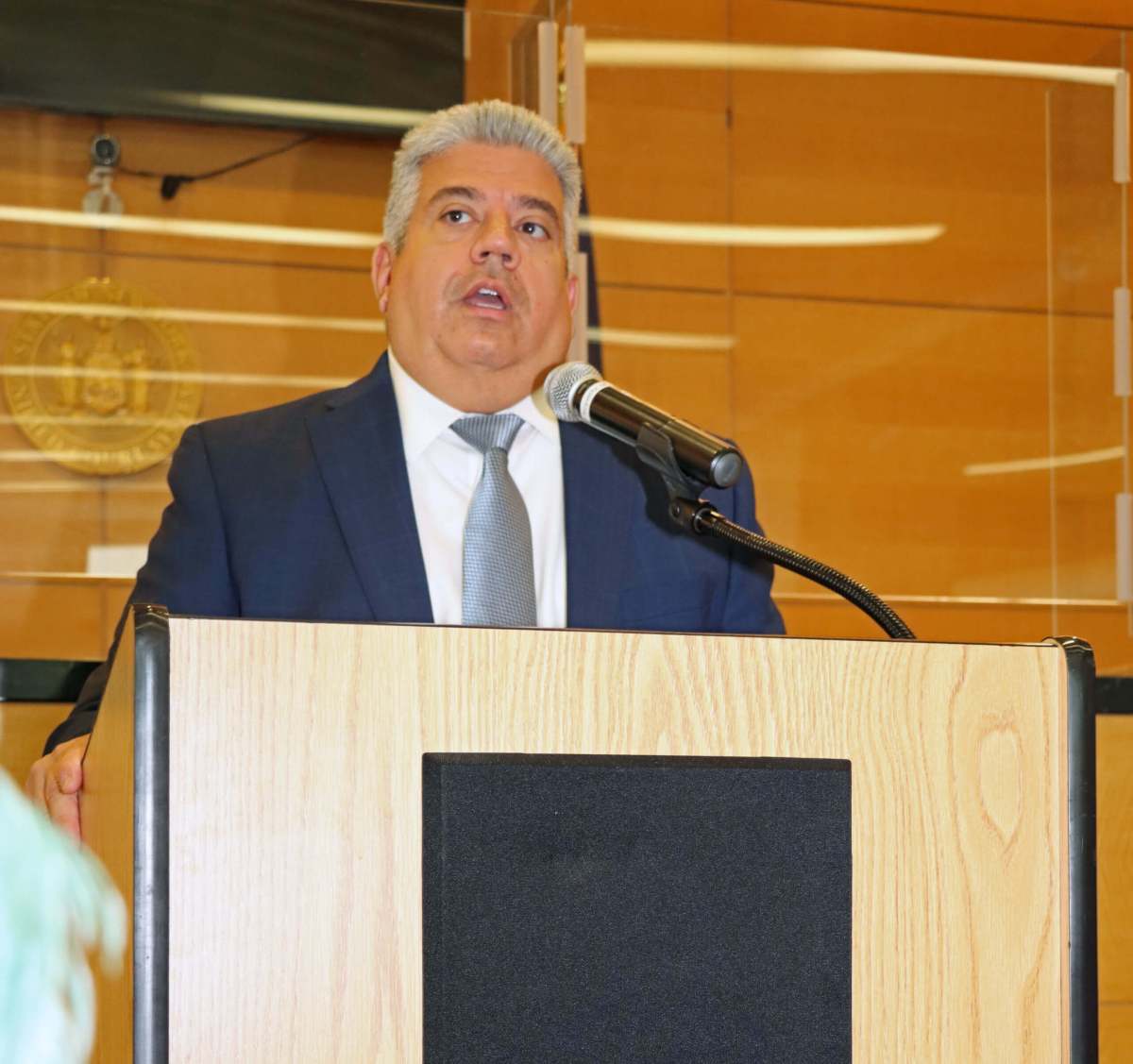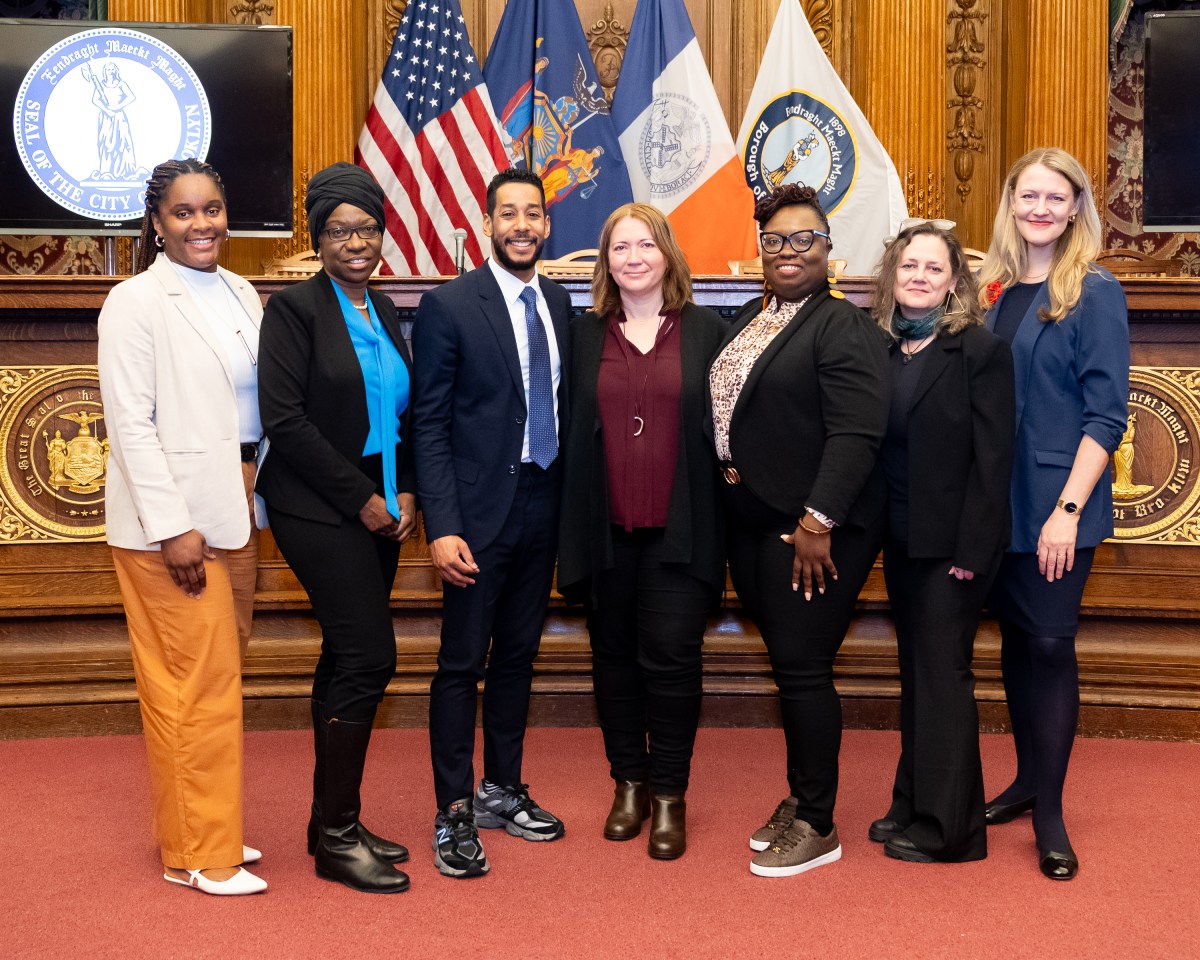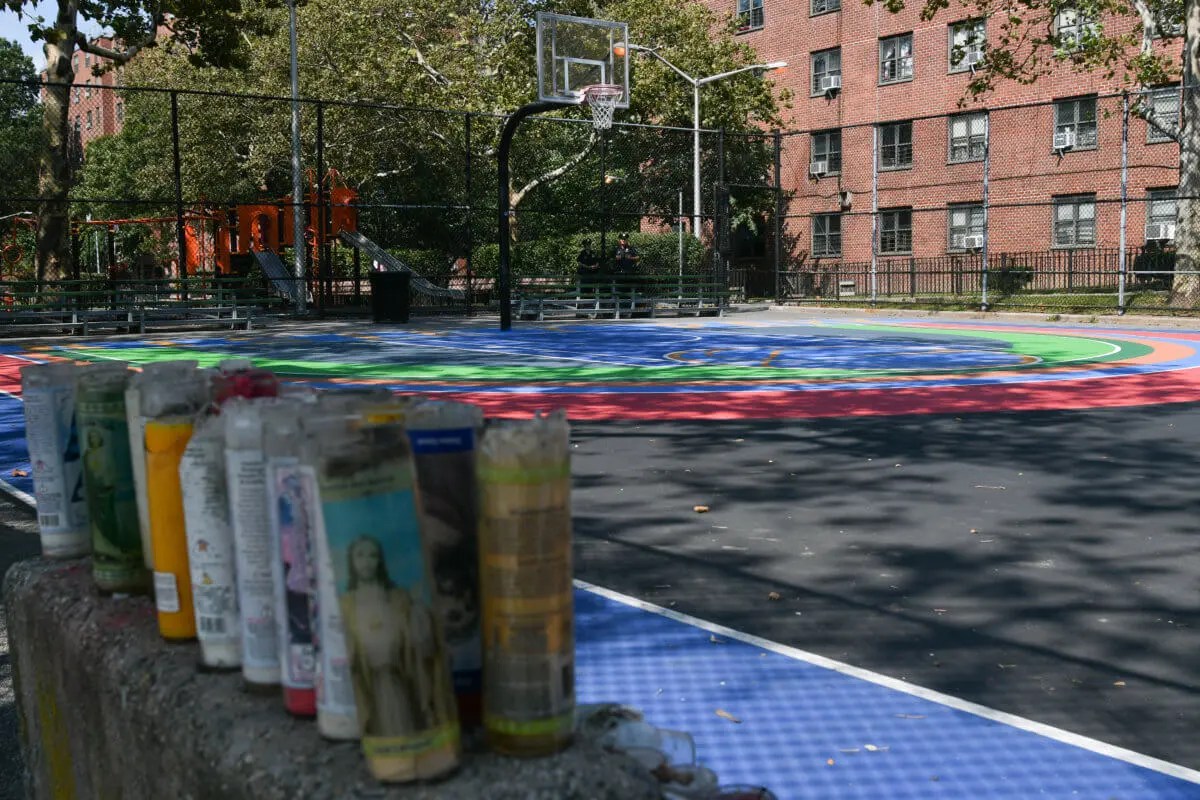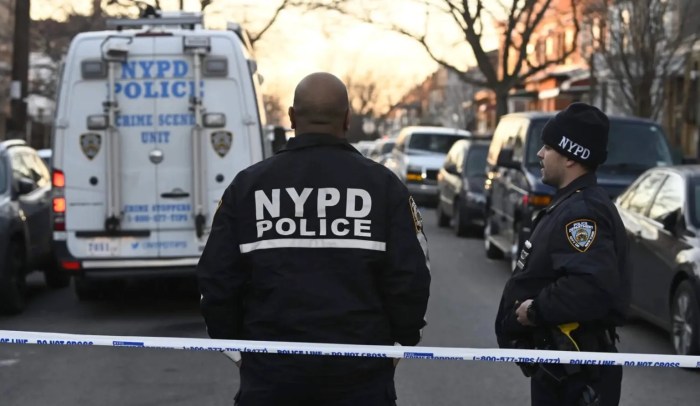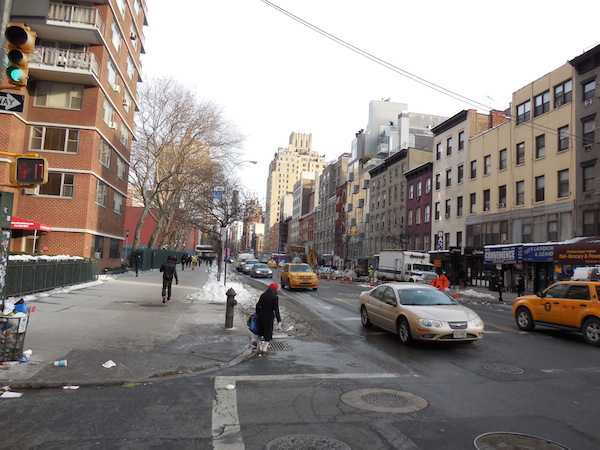
A late petition drive originating from Penn South, which favored GrowNYC, was not enough to sway CB4 from supporting Down to Earth’s bid to become the greenmarket vendor for 23rd St., btw. Eight & Ninth Aves.
BY EILEEN STUKANE | Undeterred by snow, slush, ice and a last-minute change of venue, roughly 100 residents of Community Board 4 (CB4) braved the weather to voice various quality of life concerns — when CB4 held its monthly full board meeting on Wednesday, February 5 (at the Hudson Guild on West 26th Street). While storm winds blew outside, a conflict was brewing inside — over a new farmer’s market and a contentious liquor license application.
First, though, the board discussed a special permit (later approved) for Crunch Gym to replace the David Barton gym in the old McBurney YMCA building on West 23rd Street (near Seventh Avenue). Then, a presentation was given by representatives of Brookfield Properties’ Manhattan West development.
Located near Hudson Yards, Manhattan West (on Ninth Avenue, from West 31st to 33rd Streets) is a massive, 5.4 million square-foot office, residential and hotel development of five buildings. Two 60-story North and South glass towers are to be separated by an outdoor landscaped plaza. Brookfield has applied to the NYC Department of City Planning for what’s called a “text amendment” to change the zoning for the plaza, allowing it to expand from 1.3 to 2.02 acres over Dyer Avenue and the rail yards. The application did not require a public hearing, but CB4 requested that Brookfield show the community its plans.
Presenting on behalf of Brookfield, Keith O’Connor noted that a platform would be built over the full width of Dyer Avenue from West 31st to 33rd Streets, and that the streets would be connected by an open pedestrian walkway. Slides were projected of an Entry Plaza, Central Plaza, Event Space, Pavilion and Art Plaza on the proposed expanded public space. CB4 was invited to have a representative join the Brookfield team that manages the Event Space.
Splosh, on Eighth Avenue near West 18th Street, describes itself as a “Bar & Lounge, Café and Sexy Boutique.” The 24-hour business opened its boutique portion (selling toys, lube and other adult items) in November 2013, with owner Dumesh Kankanamalage aspiring to create a multi-cuisine restaurant in the front of his first floor and on the second floor (where drinks would also be served). He applied to the State Liquor Authority (SLA) for a liquor license. Kankanamalage, who identifies his target demographic as gay men, is also the owner of the nearby Rainbow Station, a 24-hour adult establishment — but he differentiates the two businesses by the fact that there are no viewing booths or DVD pornography at Splosh.
Bill Borock, representing the Council of Chelsea Block Associations (CCBA), along with several Chelsea residents, spoke out against approval of a liquor license for what they called a “sex shop.”
“The neighborhood on Eighth Avenue between West 17th and 21st Streets is becoming a neighborhood of fun palaces with elements of prostitution that the police don’t seem to want to address,” said resident Frank Lowe (male prostitution in the neighborhood was brought up by other speakers as well). He also cited a number of safety hazards in the Splosh building, such as a demolished hallway wall and a lack of sprinklers. Another resident noted that the owner did not have a certificate of occupancy for a restaurant. CB4 had a letter of “denial” in bold type ready for the SLA.
What the outraged residents did not know at the February 5 meeting was that Kankanamalage had already given up on the effort to get a liquor license. He told Chelsea Now, in an interview this week, that he had rejected the idea of a liquor license after going to CB4’s Business License and Permits Committee meeting in January where he was faced with strong opposition. “I didn’t expect this at all,” he said, “Other businesses, which I don’t want to name, made public opinion that my business was very bad. People are scared.”
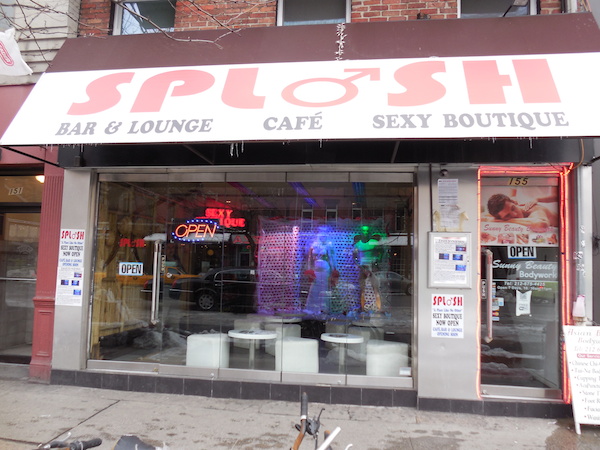
Permit to dine, but no license to serve drinks? The owner of Splosh (temporarily?) changed his business model, after a frosty reception from CB4’s Business License and Permits Committee.
Kankanamalage intends to go forward with his plans, without serving liquor. He is applying to get a restaurant permit from the NYC Department of Health and Mental Hygiene and says his architect is “working on” the necessary arrangements for a certificate of occupancy.
“I’ll wait for a liquor license,” he vowed, promising to “show my operation, and people can see what I have. They’re coming to judgment without proper knowledge of what’s going to happen. I’m not going anywhere because a few people want to sabotage my business plan. I’m not going to be intimidated or lose my determination. I’ll make it work with the community.”
Kankanamalage reports that at Splosh, he has one security camera outside and plans to install a second camera. There are 15 security cameras inside Splosh. (Rainbow Station has two outside security cameras and 32 inside). When asked about the possibility of encouraging male prostitution, Kankanamalage says he has no evidence of that. He says that he has gone to the 10th Precinct and told the police that his cameras are continuously monitored and he does not see prostitution.
CB4 Chair Christine Berthet suggested that the community show up at the 10th Precinct Community Council meetings (at 7pm on the last Wednesday of every month) to report their concerns. “I encourage all of you who came to talk about Splosh to go there and present your displeasure in the lack of enforcement. Go repeatedly. They are fully aware that there is prostitution. You need to put pressure to get what you want,” she advised.
FARMER’S MARKET FACE-OFF
The CB4 agenda included a letter (to be voted on later in the evening) to the Street Activity Permit Office (SAPO), recommending approval for a Down to Earth Farmers Market to open on the north side of West 23rd Street between Eighth and Ninth Avenues, on Saturdays from 9am to 5pm from June through November. Jon Zeltsman, president of Down to Earth, had appeared at a number of CB4 meetings, had done outreach to the community and was being sponsored by Church of the Holy Apostles — whose soup kitchen director Michael Ottley had written in a letter of support, reading: “Establishing a Down to Earth Farmer’s Market will enable ETB/SNAP, WIC and FMNP along with other citywide Food Coupons recipients to purchase fresh northeast grown food by reducing barriers and better linking local farms with local residents.” Down to Earth would also bring its unsold produce to Holy Apostles soup kitchen at the end of market days.
However, in an eleventh hour move, Cathy Chambers of GrowNYC Farmers Market, which is in Union Square, and markets throughout the five boroughs, addressed the meeting and asked that the board table its vote on the Down to Earth market until GrowNYC had a chance to make its presentation to the Quality of Life Committee. She said that GrowNYC had been invited by a resident of Penn South to apply for a permit for a Farmers Market in the same location. A petition on change.org had collected 300 signatures in favor of GrowNYC. Chambers was supported by Brian Hammerstein, the originator of the petition.
Hammerstein spoke of the nonprofit appeal of GrowNYC and the familiarity of its vendors who come to Union Square — then asked the board to table its vote. “If you vote for Down to Earth today then they’ll get the permit without GrowNYC having a chance,” he said.
Bill Borock spoke and reported that Down to Earth had done its community outreach while, “We never heard from GrowNYC and all of a sudden, at this moment, we hear there is a petition…I think one distinction is that some people are saying that Down to Earth is a for-profit certified B corporation versus GrowNYC which is not-for-profit. In a poll, six of our block associations covering 12 blocks want the Community Board not to delay a vote and to approve the vote for Down to Earth.”
Pamela Wolff, who recently resigned as a full board member (but remains as a public member), noted that she has been working with Down to Earth on its community outreach since September 2013. “I find it disturbing,” said Wolff, “that GrowNYC should be so ready to steal the petition from Down to Earth after our months of interaction with Down to Earth and the Chelsea community.”
Later in the evening, the board voted to recommend approval of Down to Earth’s street activity application. Chelsea Now attempted to contact Cathy Chambers by phone and email to learn whether GrowNYC would continue its pursuit of a Chelsea Farmers Market. No response was received. Meanwhile, Zeltsman is starting to line up vendors in anticipation of the hoped-for approval by SAPO: “We look to bring in vendors with a sufficient range of purchase prices to satisfy all residents of Chelsea, which has an economic mixture. Our objective is to provide food options for everyone.”
MARKET GONE, BUT BARS & EATERIES THRIVE
On December 31, 2013 when developers closed Stiles Farmers Market at West 41st Street and Ninth Avenue, community residents sprung into action forming Save Our Stiles and alerting CB4. A Stiles Market remains at West 52nd Street serving the northern portion of the community — but there is a dearth of options in the southern end of Hell’s Kitchen. Councilmember Corey Johnson spoke about a letter that he, Congressman Jerrold Nadler, NY State Senator Brad Hoylman and Assemblymember Richard Gottfried have sent to the Port Authority of New York and New Jersey requesting that the property at 551 Ninth Avenue, former space of Project Find’s Senior Center and owned by Port Authority, be secured for Stiles. In the evening’s agenda, CB4 also had a strong letter to Port Authority in support of that site for Stiles. The shifting nature of businesses from service establishments to bars and eateries is creating despair in the community.
Richard Grander of the West Side Neighborhood Alliance spoke for the great need for relocation of Stiles and reminded everyone of the disappearance of a Key Food, Fine Fair and two Associated markets from the area. A Catch-22, he noted, is that people who hold onto their residences can’t afford to shop locally without affordable markets. Relocating Stiles, he said, “was a way of preserving the diversity of retail.” Many in attendance applauded. All were also aware of the flip side of their losses, now regarded as the “oversaturation” issue.
“It’s the overabundance of bars that are open until 4am on Ninth Avenue,” said Diana Lawrence, a resident of West 43rd Street. “Nowadays on Friday and Saturday nights it’s like fraternity row. This is appalling, as is the intrusion of bars into the midblocks between Ninth and Tenth Avenues.” The approval of liquor licenses came into clear debate when Patrick Hughes and Dan McLaughlin, the popular owners of Lansdowne Road and Pony Bar spoke about their wish to apply for a liquor license for Kiabacca a pizza and beer establishment they hope to create adjacent to their Pony Bar on Tenth Avenue between West 45th and 46th Streets. There was no doubt that they are good operators who create jobs, boost the local economy and work with the community. However, Tom Cayler, who is involved in the Neighborhood Task Force for Business Planning under the auspices of the Hell’s Kitchen Neighborhood Association, stepped forward to ask in strong terms, “What is the saturation level the community can take?”
Cayler acknowledged Hughes and McLaughlin saying, “These guys are great, they’re terrific operators. Kiabacca will be the eleventh full liquor license within 500 feet on Tenth Avenue between West 44th and 47th Streets. How many bars per 500 feet do we need on Tenth Avenue? Eleven? Twelve? Thirteen?”
The State Liquor Authority’s 500-Foot Law states that an applicant for a liquor selling business cannot be considered if there are three other premises selling liquor within a 500-foot radius. The Neighborhood Task Force is pushing to have the 500-Foot Law enforced. The board appears to be taking the law under advisement, but not strictly adhering to it in its recommendations for liquor licenses.
CB4 TO TAKE AGGRESSIVE STANCE, ON BALANCED BUSINESS
The awareness of “oversaturation” that the community is bringing to CB4, with the increased concentration of liquor-serving businesses, along with the loss of services and long-time businesses, has motivated chair Christine Berthet to create a Balanced Business working group that will be chaired by Frank Holozubiec and comprised of members of the Business License & Permits Committee, Land Use Committee and Quality of Life Committee. “I just want to warn everyone that this is new territory,” said Berthet, “We cannot and will not guarantee that we will have short-term results or short-term improvements. However, we feel it is necessary to tackle this issue because the community is asking for it. We may just turn and say we need new laws. Essentially this is an effort of faith.”
Afterward, Berthet explained to Chelsea Now that a need for tackling the Balanced Business issue is being felt throughout the city.“CB3 has formed a study group and Borough President Gale Brewer has looked into how to preserve long-term businesses in the Upper West Side neighborhoods,” she said. When it came time to vote, the board voted to approve Kiabacca’s liquor license as long as promised soundproofing was installed.
REPORTS FROM ELECTEDS WHITTLED DOWN ON SITE, BEEFED UP ONLINE
The meeting included a visit from Jennifer Gerson, the new executive director of the High Line who assured everyone of her accessibility with “I want to make sure that the High Line feels like this neighborhood’s as much as it is an international attraction.”
Abby Murray, operations associate at the Meatpacking District Improvement Association, reported that progress is being made on the creation of a Meatpacking Business Improvement District (MBID) and plans will be presented to CB4’s Land Use Committee on February 25.
In his district manager’s report, Bob Benfatto announced that CB5 would be holding a Town Hall meeting on February 19 at 6pm, at the Museum of Art and Design (2 Columbus Circle) to discuss proposed skyscraper type buildings that would shadow Central Park.
Berthet announced that newsletters and reports from elected officials would now be available online at nyc.gov/mcb4 (the website of CB4). Sign-up sheets were available for those who wanted the link sent to them directly. Also, elected officials would be taking turns, half at a time, reporting on alternate meeting dates to increase the efficient use of time at full board meetings.
NY State Senator Brad Hoylman spoke about his support for co-terminality, a request to NYC Police Department Commissioner William Bratton to align the boundary between the 13th and 10th Precincts with the boundary between CB4 and CB5. This would unite the blocks from 14th Street to 26th Street between Sixth and Seventh Avenues with the rest of the Chelsea neighborhood in the jurisdiction of the 10th Precinct.
Hoylman is also hosting Counting Down To “Vision Zero,” A Traffic and Pedestrian Safety Town Hall forum to discuss plans for the safe co-existence of pedestrians, cyclists and motorists on city streets. The event will take place on February 25, 6-8pm, John Jay College of Criminal Justice (524 West 59th Street, sixth floor).
Representing Comptroller Scott Stringer, Dan Campanelli announced that Stringer has initiated a top to bottom audit of NYCHA and he is also looking into the how the city’s library systems are spending their money, from executive pay to the funding of capital projects.
The meeting wound down with votes on letters of recommendation, approval and denial covering other issues, among them a ratification sent to Empire State Development for the future of Bayview Correctional Facility, a letter to Councilmember Corey Johnson in regard to finding a permanent location for an EMS facility now located under the High Line at 512 West 32rd Street and seven letters sent to the SLA regarding liquor licenses.




